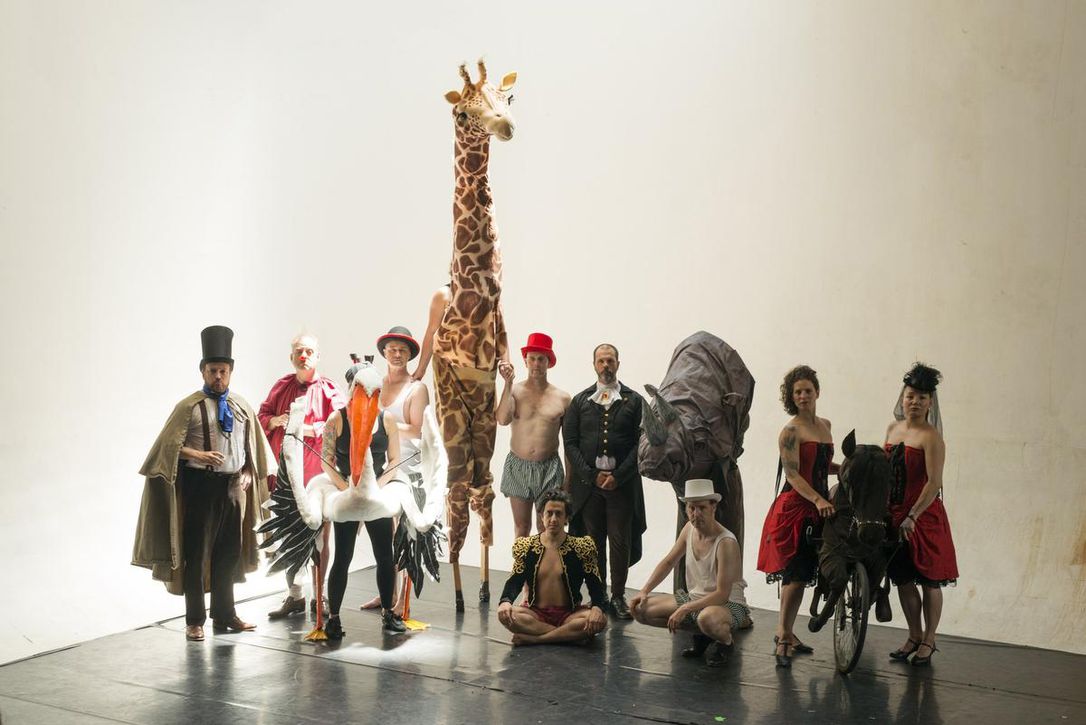“Dirty rotten clowns! Dirty rotten clowns! Dirty rotten clowns!” The chant rings through the air on this cool and rainy Wednesday evening. An angry crowd of Orangemen, made up of performers and audience members alike, march through an alley toward a blue and white circus tent. There, awaiting the crowd’s arrival, are those dirty rotten clowns and the rest of the circus too. The riot is on!
The Toronto Circus Riot, produced by Toronto’s Lookup Theatre, has been a labour of love for artistic director Angola Murdoch, spanning several years. It was in 2008 that Angola and her husband bought a pocket of land outside of Toronto in a small hamlet called Purple Valley. She discovered that the Orangemen, a powerful Protestant fraternal order that wielded great power and political influence at the time, had a lodge in the area. Through her research she discovered much about the Orangemen and eventually came across the story of the Toronto circus riot.
The year was 1855. S.B. Howes’ Star Troupe Menagerie & Circus, a traveling circus from New York State, arrived in Toronto in early July and set up their tents. After a long day’s work, a few of the clowns got together and headed down to Mary Ann Armstrong’s brothel for a drink and to get to know some of the ladies on staff. There they met the Hooks and Ladders, a group of local firefighters that also happened to be Orangemen. A fight broke out in the brothel and in the end the clowns came out on top. That didn’t sit well with the Hooks and Ladders crew who headed down to the circus and (ironically) tried to burn down the troupe’s tent. After the kerfuffle, the circus pulled up stakes and left town. The Orangemen were left to stand trial for the riot.

It must be noted that the basis of the script for The Toronto Circus Riot relies heavily on factual accounts that Angola painstakingly researched. Spending hours in the basement of the Toronto Reference Library pouring through historical archives and eventually finding microfiche from reporting in The Globe newspaper (now the Globe and Mail) of the events at the time, she conceptualised an immersive theatrical circus event, the likes of which she had not witnessed before. “I wanted the circus to make sense throughout in a theatrical sense and not just through metaphorical storytelling.” The story accomplishes this in creative ways that do not necessarily wow with eye-popping tricks, but engage the audience in their authenticity.
“I want circus people to do more theatrical work,” Angola states. In this rendition of the script (there have been several), writer Reid Janisse, who also performs in the show as several characters including Fawcett, the main antagonist and Orangeman, allows the characters room to grow and develop. In previous iterations, the story was told more so through narration as opposed to dialogue, but this has changed. “The narrative has developed to develop the characters so that we get to know them and the story better,” she says. Having a great deal of exposition risks becoming clunky, but the cast are talented and have fun with the parts they’re playing so that it works together fairly seamlessly.
Historically and theatrically, the shenanigans of clowns Lefty (Jerry Schaefer), Rodrigo (Kris Siddiqi), and Myers (Allan Turner) truly are at the centre of the circus riot story. The three veteran actors, comedians and improvisors turn in scene-stealing comedic performances that garner belly laughs from all in the audience. Their comedic timing and improvisations were quick-witted and cutting and their physical comedy performance top notch in both their scenes as clowns in the circus and during the choreographed fight scenes inside brothel and during the outdoor riot.
If you are looking for more traditional circus fare, you certainly will see hand-to-hand acrobatics, hand balancing, juggling, and aerial performances skillfully executed by an extensive cast that includes some of Toronto’s most talented circus artists, but it never seems to be forced or stuck in just because it’s a circus show. In the brothel, red “curtains” are set decor before they are revealed as an aerial apparatus and the burlesque-inspired silks performances by Lara Ebata, Natalie Fullerton, and Holly Treddenick are simply sexy, garnering hoots and hollers from all!

In a tip-of-the hat to the influence that equestrian acts of the time had on circus attractions, there is even a horse and stunt rider act. Since a real horse wasn’t available for the production, an apparatus was devised. Angola worked with puppeteer Kelsey Carriere, the same designer that crafted the beautiful giraffe, rhino, pelican, and zebra puppets for the menagerie, to animate an aerial horse. “We tried various ways to make the aerial horse work. Because of centrifugal force, it was very difficult to control at first, but we made it work,” says Angola. The brief appearance by the aerial horse and her riders, Treddenick and Ebata, is a unique performance demonstrating the grace, strength, balance, and of course humour of the cast and the show itself.
Like S.B. Howes’ Star Troupe Menagerie & Circus, The Toronto Circus Riot is in town for a good time and not a long time. After nine performances, the show will be pulling up its stakes and putting away its tent. Until then, lucky audiences in Toronto will have the opportunity to step back in time and become a part of this city’s little-known and very entertaining local history.



